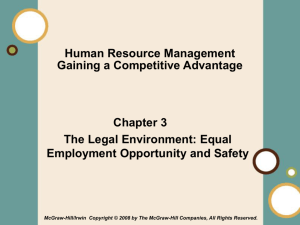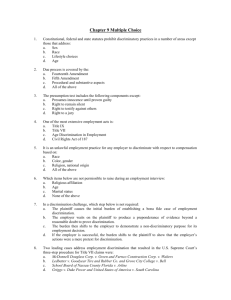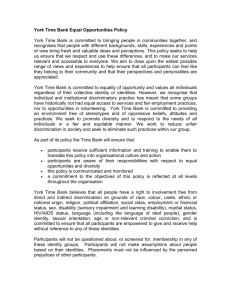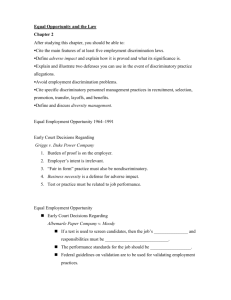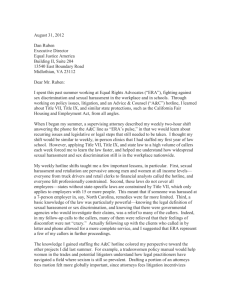Chapter 3
advertisement
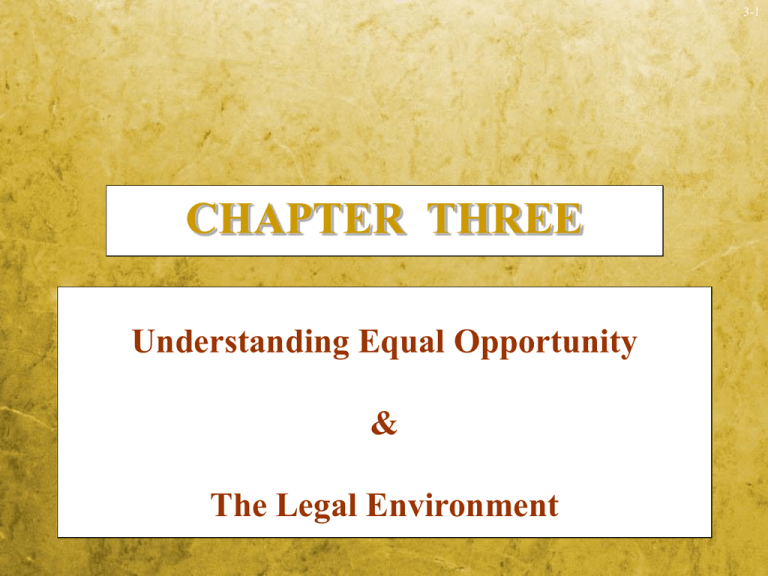
3-1 CHAPTER THREE Understanding Equal Opportunity & The Legal Environment 3-2 Chapter Objectives Understanding why compliance with HR laws is important Review and understand progression of HR laws To help understand how managers can make decisions that will help avoid legal liability Review Key Terms Affirmative Action Disparate impact Disparate treatment Hostile Work Environment Protected Class Quid pro quo 3-3 Why Understanding the Legal Environment Is Important Assists in realizing what is the right thing to do… Helps employees understand the limitations of the HR and Legal departments Facilitate a fair and humane environment Can limit potential liability Who to hire How to compensate employees What benefits to offer How to accommodate employees with dependents How and when to fire employees 3-4 Conflicting Strategies for Fair Employment 3-5 Conflicting Strategies for Fair Employment Affirmative Action: A phrase describing a range of policies to seek out, encourage and sometimes give preferential treatment to individuals in protected groups Allowed when breaks down historic patterns of discrimination All employees should be “essentially equally qualified” No absolute barriers to white employees No discharge of white workers Flexible and temporary May be court ordered 3-6 Affirmative Action Executive Order Executive Orders 11246 and 11375 Presidential directive that has force of the law – all federal agencies and organizations doing business with the federal government must comply Require affirmative action: steps that are taken for the purpose of eliminating the present effects of past discrimination Office of Federal Contract Compliance Programs (OFCCP) Responsible for implementing the executive orders related to affirmative action and ensuring the compliance of federal contractors 3-7 Equal Employment Opportunity Laws The Equal Pay Act of 1963 Title VII of the Civil Rights Act of 1964 The Age Discrimination in Employment Act of 1967 The Vietnam Era Veterans Readjustment Act of 1974 The Americans with Disabilities Act of 1990 Civil Rights Act of 1991 (most recent amendment to Civil Rights Act of 1964) 3-8 The Equal Pay Act of 1963 An amendment to the Fair Labor Standards Act. It requires that male and female workers receive equal pay for work requiring equal skill, effort and responsibility, and performed under similar working conditions. Wage differentials are permitted, however, if they are based on factors other than sex, such as a seniority system, a merit system, or a system measuring earnings by quantity or quality of production. 3-9 Key Terms Protected Class A group of people who have suffered discrimination in the past and who are give special protection by the judicial system Disparate treatment African Americans Asian Americans Latinos Native Americans Women Intentional discrimination on the part of the employer Disparate impact A practice or policy that has a greater adverse impact on the members of a protected group than on other employees, regardless of intent. 3-10 Disparate Treatment Title VII of the Civil Rights Act of 1964 Disparate Intentional discrimination on the part of the employer Title Treatment: VII of the Civil Rights Act of 1964 It is unlawful to fail or refuse to hire or to discharge an individual or otherwise to discriminate against any individual with respect to his/her compensation, terms, conditions, or privileges of employment because of such individual’s race, color, religion, sex, or national origin. It is unlawful to limit, segregate, or classify his/her employees or applicants for employment in any way that would deprive or tend to deprive any individual of employment opportunities or otherwise adversely affect his/her status as an employee because of such individual’s race, color, religion, sex, or national origin. 3-11 Title VII of the Civil Rights Act of 1964 An employer cannot discriminate on the basis of race, color, religion, sex, or national origin with respect to employment. Coverage All public or private employers of 15 or more persons. All private and public educational institutions, the federal government, and state and local governments All public and private employment agencies All labor unions with 15 or more members Created the Equal Employment Opportunity Commission (EEOC) 3-12 Title VII of the Civil Rights Act of 1964 The Equal Employment Opportunity Commission (EEOC) Consists of five members appointed by the president with the advice and consent of the Senate. Each member serves a five-year term. The EEOC has a staff of thousands to assist it in administering the Civil Rights law in employment settings. EEOC may file discrimination charges and go to court on behalf of aggrieved individuals. 3-13 Disparate Impact Griggs v. Duke Power Company (1971) Disparate impact A practice or policy that has a greater adverse impact on the members of a protected group than on other employees, regardless of intent. Griggs v. Duke Power Company: Case heard by the Supreme Court in which the plaintiff argued that his employer’s requirement that coal handlers be high school graduates was unfairly discriminatory. In finding for the plaintiff, the Court ruled that discrimination need not be overt to be illegal, that employment practices must be related to job performance, and that the burden of proof is on the employer to show that hiring standards are job related. Discrimination by the employer need not be overt; employer’s intent is irrelevant. An employment practice must be job related and valid if it has an unequal impact on members of a protected class. The burden of proof is on the employer to show that the employment practice is job related. Business necessity is the employer’s defense for any practice that has adverse impact. 3-14 Disparate Impact Albemarle Paper Company v. Moody (1975) Disparate impact A practice or policy that has a greater adverse impact on the members of a protected group than on other employees, regardless of intent. Albemarle Paper Company v. Moody: reaffirmed the idea that any test used in the selection process or in promotion decisions must be validated if it is found that its use has had an adverse impact on women and minorities If an employer uses a test to screen candidates, then the job’s specific duties and responsibilities must be carefully analyzed and documented. The performance standards for employees on the job in question should be clear and unambiguous. EEOC (now federal) guidelines on validation are to be used for validating employment practices 3-15 Determining Discrimination McDonnell Douglas Test McDonnell Douglas Test to Establish a Prima Facie (legally sufficient) Case of Discrimination: The person is a member of a protected class. The person applied for a job for which he or she was qualified. The person was rejected, despite being qualified. After rejection, the employer continued to seek other applicants with similar qualifications. The burden now shifts to the employer to prove that the action taken against the individual was not discriminatory. 3-16 Defense of Discrimination Charges Four-fifths Rule Four-fifths rule EEOC’s Uniform Guidelines on Employee Selection Procedures A selection rate for any race, sex, or ethnic group which is less than four-fifths or 80 percent of the rate for the group with the highest rate generally is regarded as evidence of adverse impact Rule of thumb followed by the EEOC in determining adverse impact for use in enforcement proceedings. According to the Uniform Guidelines, a selection program has an adverse impact when the selection rate for any racial, ethnic, or sex class is less than four-fifths (or 80 percent) of the rate of the class with the highest selection rate. The four-fifths rule is not a legal definition of discrimination, rather it is used to monitor severe discrimination practices. 3-17 Defense of Discrimination Charges Four-fifths Rule 3-18 Defense of Discrimination Charges Four-fifths Rule Employees Number Given Raise Selection Ratio Minority Selection Ratio/ M ajority Selection Ratio Adverse Impact Blacks (6) Hispanics (3) Whites (12) 2 2 9 .33 .66 .75 .33/.75 = .44 .66/.75 = .88 Yes No 3-19 Defense of Discrimination Charges Job Relatedness: BFOQ: Bona Fide Occupational Qualification. Requirement that an employee be of a certain religion, sex, or national origin where that is reasonably necessary to the organization’s normal operation. Specified by the 1964 Civil Rights Act. Seniority: Business can show that the decision was made for job- related reasons. Formal seniority systems are permitted - must be well established and applied universally Business necessity: Defense created by the courts, which requires an employer to show an overriding business purpose for the discriminatory practice and that the practice is therefore acceptable. (drug testing) 3-20 Title VII and Pregnancy Pregnancy Discrimination Act (PDA) of 1978 A Title VII amendment that prohibits sex discrimination based on “pregnancy, childbirth, or related medical conditions.” If an employer offers its employees disability coverage, then it must treat pregnancy and childbirth like any other disability, and include it in the plan as a covered condition. 3-21 Title VII: Sexual Harassment Sexual harassment Harassment on the basis of sex that has the purpose or effect of substantially interfering with a person’s work performance or creating an intimidating, hostile, or offensive work environment. Employers have an affirmative duty to maintain workplaces free of sexual harassment and intimidation. 3-22 Sexual Harassment Defined Unwelcome sexual advances, requests for sexual favors, and other verbal or physical conduct of a sexual nature that takes place under any of the following conditions: Submission to such conduct is made either explicitly or implicitly a term or condition of an individual’s employment. Submission to or rejection of such conduct by an individual is used as the basis for employment decisions affecting such individual. Such conduct has the purpose or effect of unreasonably interfering with an individual’s work performance or creating an intimidating, hostile, or offensive work environment. 3-23 Sexual Harassment Two Broad Categories Quid pro quo Occurs when “submission to or rejection of sexual conduct is used as a basis for employment decisions” Involves a tangible or economic consequence, such as a demotion or loss of pay Hostile Work Environment Occurs when unwelcome sexual conduct has the purpose or effect of unreasonably interfering with job performance or creating an intimidating, hostile, or offensive working environment. Dirty jokes, vulgar slang, nude pictures, swearing, and personal ridicule and insult constitute sexual harassment when an employee finds them offensive. Courts use a “reasonable person” test for hostile environment. 3-24 Sexual Harassment Two Broad Categories In a quid pro quo case it is not necessary for the employee to have suffered a tangible job action to win the case. The employer (in its defense) must show that it took reasonable care to prevent and promptly correct any sexually harassing behavior and that the employee unreasonably failed to take advantage of the employer’s policy. 3-25 Sexual Harassment Court Cases Meritor Savings Bank, FSB v. Vinson (1986) Burlington Industries v. Ellerth (1998) 1986 landmark sexual harassment decision, requiring the very nature of such harassment to be so "severe or pervasive as to alter the conditions of the victim's employment and create an abusive working environment." even if an employee does not suffer any financially-tangible, job-related harm from a supervisor's sexual harassment, she or he may still hold the employer liable for other forms of injury. Oncale v Sundowner Offshore Services (1998) Same-sex sexual harassment (male-to-male, female-to-female) is covered under Title VII. 3-26 Sexual Harassment Reducing Potential Liability Take all complaints about harassment seriously. Issue a strong policy statement condemning such behavior. Inform all employees about the policy and of their rights. Develop and implement a complaint procedure. Establish a management response system that includes an immediate reaction and investigation by senior management. Begin management training sessions with supervisors and managers to increase their awareness of the issues. 3-27 Sexual Harassment Reducing Potential Liability Discipline managers and employees involved in harassment. Keep records of complaints, investigations, and actions taken. Conduct exit interviews that uncover any complaints and that acknowledge by signature the reasons for leaving. Re-publish the sexual harassment policy periodically. Encourage upward communication through periodic written attitude surveys, hotlines, suggestion boxes, and other feedback procedures. 3-28 The Age Discrimination in Employment Act of 1967 The act prohibiting arbitrary age discrimination and specifically protecting individuals over 40 years old. 3-29 Age Discrimination in Employment Ways to Increase Potential Liability Excluding older workers from important work activities. Making negative changes in the performance evaluations of older employees. Denying older employees job-related education, career development, or promotional opportunities. Selecting younger job applicants over older, betterqualified candidates. Pressuring older employees into taking early retirement. Reducing the job duties and responsibilities of older employees. Terminating older employees through downsizing 3-30 The Vietnam Era Veterans Readjustment Act of 1974 The law requires that employers with Federal contracts or subcontracts of $25,000 or more provide equal opportunity and affirmative action for Vietnam era veterans, special disabled veterans, and veterans who served on active duty during a war or in a campaign or expedition for which a campaign badge has been authorized. 3-31 State and Local Equal Employment Opportunity Laws The effect of the state and local laws is usually to further restrict employers’ treatment of job applicants and employees. State and local laws cannot conflict with federal law but can extend coverage to additional protected groups. The EEOC can defer a discrimination charge to state and local agencies that have comparable jurisdiction. 3-32 Americans with Disabilities Act (ADA) ADA of 1990 Requires employers to make reasonable accommodations for disabled employees; it prohibits discrimination against disabled persons. Disability A physical or mental impairment that substantially limits one or more major life activities. 3-33 Americans with Disabilities Act (ADA) The ADA does not cover: Homosexuality or bisexuality Gender-identity disorders not resulting from physical impairment or other sexual-behavior disorders Compulsive gambling, kleptomania, or pyromania Psychoactive substance-use disorders resulting from current illegal use of drugs Current illegal use of drugs Infectious or communicable diseases of public health significance (applied to food-handling jobs only and excluding AIDS) 3-34 Americans with Disabilities Act (ADA) Qualified individuals Under ADA, those who can carry out the essential functions of the job. Reasonable If accommodation the individual can’t perform the job as currently structured, the employer must make a “reasonable accommodation” unless doing so would present an “undue hardship.” 3-35 Americans with Disabilities Act (ADA) An employer must make a reasonable accommodation for a qualified disabled individual unless doing so would result in undue hardship. Employers are not required to lower existing performance standards or stop using tests for a job. Employers may ask pre-employment questions about essential job functions but can not make inquiries about disability. Essential (each person in certain position must be able to do) vs. Marginal (not critical to job performance) Medical exams (or testing) for current employees must be jobrelated. Employers should review job application forms, interview procedures, and job descriptions for illegal questions and statements. 3-36 Americans with Disabilities Act (ADA) Employers should have up-to-date job descriptions that identify the current essential functions of the job. Courts will tend to define “disabilities” quite narrowly. Employers are not required to tolerate misconduct or erratic performance even if the behaviors can be attributed to the disability. Employers do not have create a new job for the disabled worker nor reassign that person to a light-duty position for an indefinite period, unless such a position exists. 3-37 ADA Suggestions for an Accessible Workplace Install easy-to-reach switches. Provide sloping sidewalks and entrances. Install wheelchair ramps. Reposition shelves for the easy reach of materials. Rearrange tables, chairs, vending machines, dispensers, and other furniture and fixtures. Widen doors and hallways. Add raised markings on control buttons. Provide designated accessible parking spaces. Install hand controls or manipulation devices. Provide flashing alarm lights. Remove turnstiles and revolving doors or provide alternative accessible paths. Install holding bars in toilet areas. Redesign toilet partitions to increase access space. Add paper cup dispensers at water fountains. Replace high-pile, low-density carpeting. Reposition telephones, water fountains, and other needed equipment. Add raised toilet seats. 3-38 Civil Rights Act of 1991 (CRA) Impact of CRA: Burden of Proof Quotes Explicitly forbidden Damages & Jury Trails Once plaintiff shows disparate impact (prima facie case) , the employer has the burden of proving that the challenged practice is job related permits compensatory and punitive damages - makes it easier to sue for money damages in certain cases Expanded Coverage amending the definition of employee to mean a U.S. citizen employed in a foreign country by a U.S.-owned or -controlled company 3-39 Civil Rights Act of 1991 (CRA) Provide appropriate remedies for intentional discrimination and unlawful harassment Clarified the concepts of business necessity and job related Confirm authority and guidelines for finding of disparate impacts under Title VII Responded to recent Supreme Court decisions 3-40 Avoiding Pitfalls in EEO Provide Training Document Decisions Be Honest Establish a Complaint Resolution Process Ask Only for Info You Need to Know 3-41 Discriminatory Employment Practices Recruitment Selection Word of Mouth Educational Requirements Misleading Information Preference to Relatives Help Wanted Ads Height, Weight, and Physical Characteristics Arrest Records Application Forms Discharge Due to Garnishment Personal Appearance Dress Hair Uniforms 3-42 Questions to Ask When an Employer Receives Notice That EEOC has Filed a Bias Claim 1. Exactly what is the charge and is your company covered by the relevant statutes? 2. What protected group does the employee belong to? Is the EEOC claiming disparate impact or disparate treatment? 3. Are there any obvious bases upon which you can challenge and/or rebut the claim? 4. If it is a sexual harassment claim, are there offensive comments, calendars, posters, screensavers, and so on, on display in the company? 5. Who are the supervisors who actually took the allegedly discriminatory actions and how effective will they be as potential witnesses?

